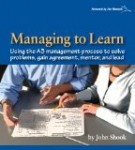 Managing to Learn by John Shook is the latest in the classic series of books published by the Lean Enterprise Institute.
Managing to Learn by John Shook is the latest in the classic series of books published by the Lean Enterprise Institute.
It is subtitled “Using the A3 management process to solve problems, gain agreement, mentor, and lead” and that pretty well sums it up.
Like many of the previous LEI books, it is built around a straightforward working example as a vehicle to demonstrate the basic principles. As such, it shares all of the strengths and shortcomings of its predecessors.
In my admittedly limited experience, I have seen a couple of companies try to embrace similar processes without real success. The main issue has been that the process quickly became “filling out a form.” Soon the form itself became (if you will pardon the term) a pro-forma exercise. Leadership did not directly engage in the process; and no one challenged a shortcut, jumping to a pet solution, or verified actual results (much less predicted them). Frankly, in these cases, it was either taught badly from the beginning, or (probably worse) the fad spread more quickly than the organization could learn how to do it well.
I must admit that with the recent flood of books and articles about the “A3” as the management and problem solving tool of lean, that we will see a macro- case of the same though throughout industry.
Managing to Learn tries to address this by devoting most of its emphasis on how the leader teaches by guiding and mentoring a team member through the problem solving process. The reader learns the process by following along with this experience, vs. just being told what to put in each block of the paper.
To illustrate this in action, the narrative is written in two tracks. One column describes the story from the problem solver’s viewpoint as he is guided through the process. He jumps to a conclusion, is pulled away from it, and gently but firmly directed through the process of truly understanding the situation; the underlying causes; developing possible countermeasures and implementing them.
Running parallel to that is another column which describes the thoughts of his teacher / manager.
Personally, found this difficult to follow and would prefer a linear narrative. I am perfectly fine with text that intersperses the thoughts and viewpoints of the characters with the shared actions. But given this alternative choice of format, I would have found it a lot easier to track if there had been clear synchronization points between the two story lines. I found myself flipping back and forth between pages, where sentences break from one page to the next in one column, but not the other, and it was difficult to tell at what point I was losing pace with the other column.
To be clear, Shook says in the introduction that the reader can read both at once (as I attempted to do), read one, then the other, or any other way that works. I tried, without personal success, to turn it into a linear narrative by reading a bit of one, then the other.
The presentation format not withstanding, Shook drives home a few crucially important points about this process.
- It is not about filling out the form. It is a thought process. Trying to impose a structured form inevitably drives people’s focus toward filling out the form “correctly” rather than solving the problem with good thinking.
- He emphasizes the leadership aspect of true problem solving. The leader / teacher may even have a good idea what the problem and solution are, but does not simply direct actions. Instead, the leader guides his team member through the process of discovering the situation for himself. This gets the problem solved, but also develops the people in the organization.
There are also a few real gems buried in the text – a few words, or a phrase in a paragraph on a page – that deserve to have attention called out to them. I am going to address those in separate posts over the next few days.
In the end this book can provide a glimpse of a future state for leadership in a true learning and problem solving culture. But if I were asked if the message is driven home in a way that passes the “sticky test” then I have to say, no. I wish it did, we need this kind of thinking throughout industry and the public and government sectors.
Thus, while this book is very worthwhile reading for the engaged practitioner to add to his insight and skill set, it is not a book I would give someone who was not otherwise enlightened and expect that he would have a major shift in his approach as a result of reading it.
The bottom line: If you are reading this in my site, you will probably find this book worthwhile, but don’t expect that having everyone read it will cause a change in the way your organization thinks and learns.
 Managing to Learn
Managing to Learn